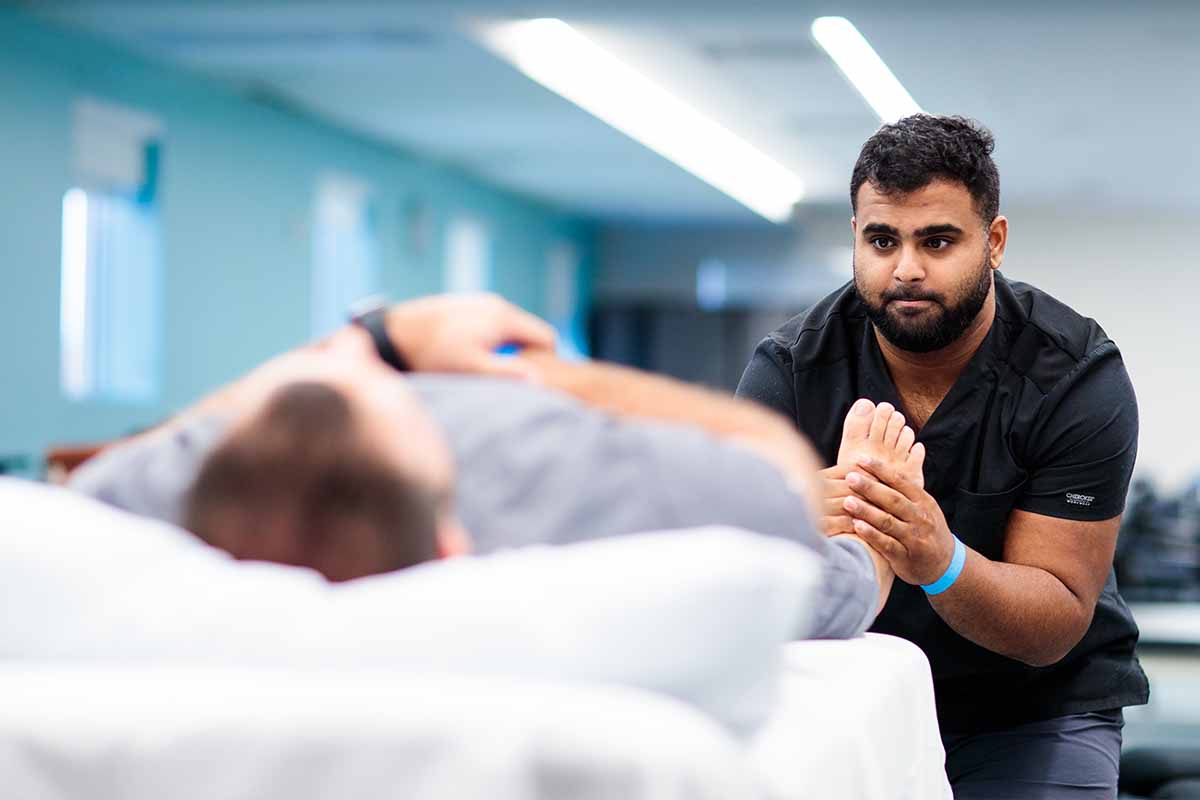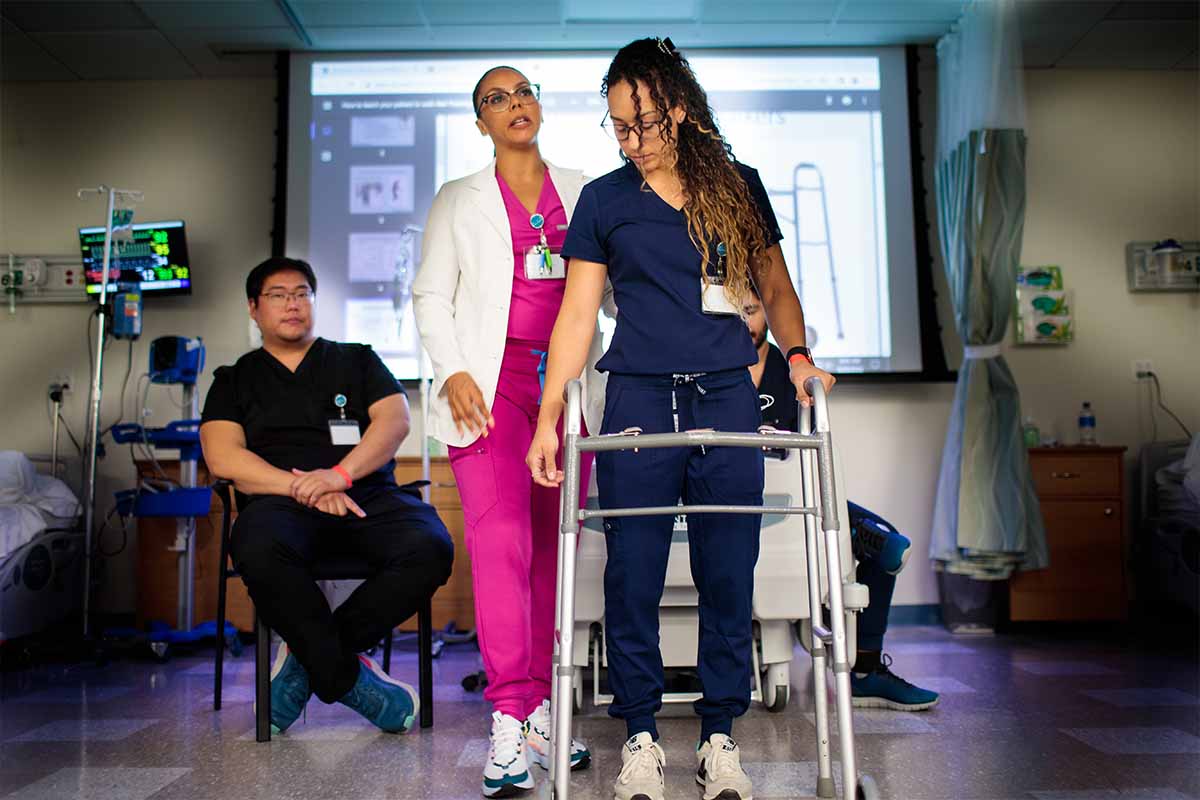
Many graduate healthcare programs, ranging from medical and nursing school to physical therapy degree programs, hold a white coat ceremony as a rite of passage for students. This ritual signifies students’ entrance into the medical profession and recognizes all their hard work that led up to this point.
Whether you are on the journey to becoming a physical therapist, a nurse, or another type of health care professional, we cover everything to know about this important milestone in your medical education journey.
What Is a White Coat Ceremony?
A white coat ceremony marks the end of a cohort’s period of classroom learning and the beginning of their clinical rotations, when they begin to work with real patients. The short white lab coat presented to students at the ceremony is an incremental step toward the long white coat they may receive once they’ve completed their degree.


“The point is to recognize the hard work the DPT students have put in for their first four terms in their didactic coursework and hands-on simulations before they move into their clinical rotations,” explains Cherie Peters-Brinkerhoff, PT, EDD, MPT, MHA, C/NDT, director of the DPT program on the San Marcos campus of the University of St. Augustine for Health Sciences (USAHS). “It’s not graduation. It’s a time for the medical student to reflect on their professional journey so far: what they have learned and how they have grown.”
What Does the White Coat Ceremony Mean?
In 1993, Arnold P. Gold, MD, organized the first full-fledged medicine white coat ceremony at Columbia University College of Physicians and Surgeons. The tradition rapidly spread to other medical schools and to schools educating other healthcare professionals who wear the white lab coat. (( S J Huber, “The white coat ceremony: a contemporary medical ritual,” Journal of Medical Ethics, vol. 29, issue 6: https://jme.bmj.com/content/29/6/364))
Physicians began wearing the white lab coat in the late nineteenth century to symbolize the profession’s disavowal of snake oil remedies and its embrace of sound scientific principles and research. ((Mark S. Hochberg, “The Doctor’s White Coat: An Historical Perspective,” AMA Journal of Ethics, April 2007: https://journalofethics.ama-assn.org/article/doctors-white-coat-historical-perspective/2007-04))
The first USAHS program and campus to adopt this tradition was its Doctor of Physical Therapy (DPT) program at the school’s founding campus in St. Augustine, Florida. Now, thanks to the program’s three start dates per year (on four of its five campuses), new DPT cohorts enter clinical rotations every trimester—so the ceremony is performed every term for eligible cohorts across USAHS campuses. (Currently, the ceremonies are held virtually due to COVID-19.)
What Happens at a White Coat Ceremony?
Individual schools decide what their ceremony looks like. Typically, ceremonies include a keynote speaker, the recitation of an oath, and the presentation of the white coat. Usually, there’s a reception afterward where the medical student can celebrate with their cohort and guests. A typical ceremony includes the following elements:
- The keynote speaker, often a dean or another academic leader, gives an inspiring speech to kick things off.
- Students recite an oath that reinforces their pledge to uphold professional ethics and deliver excellent patient care. This is typically a modernized version of the Hippocratic Oath.
- Students cross the stage and are cloaked with a white coat. Faculty or administrators typically bestow the coats on students. Students may also receive a symbolic gift such as a pin, crest, or a stethoscope.
This year, many schools have chosen to either delay or shift the ceremony to a virtual format because of the COVID-19 pandemic. For virtual ceremonies, the students receive the coats in advance, and a family member or significant other helps them put it on.


At USAHS, the white coat ceremony takes place near the end of the DPT students’ fourth term. Walking to the beat of inspiring songs they’ve chosen together, the students take the stage. As a group, they recite the Hippocratic Oath for Physical Therapists, an adapted version of the Hippocratic Oath. Then faculty members help each student, one by one, don a short white lab coat as a symbol of their readiness to enter the clinical world.
Once the students are wearing their coats, they each receive a pin with the University’s crest. A person chosen by the student—a parent, significant other, or friend—has the honor of fastening the pin.
When Does the White Coat Ceremony Happen?
For the USAHS DPT program, the white coat ceremony typically occurs near the end of the students’ fourth term, before they begin clinical rotations. However, this varies depending on the program and school. Some medical schools hold it on the first day of school right before new student orientation—or during the final graduation ceremony.
How Long Is a White Coat Ceremony?
The ceremony can last anywhere from one to two hours. It’s typically followed by recessional music and/or a reception where faculty, students, and guests can mingle. Of course, virtual ceremonies have virtual receptions.
What to Wear to a White Coat Ceremony
Business casual attire is perfectly acceptable. For example, men may wear a button-down shirt and dress pants. Women might wear a dress or a blouse and dress pants.
Which Professions Have a White Coat Ceremony?
Several healthcare professions have made the ceremony a ritual to commemorate their students. These schools include medical, nursing, dental, optometry, pharmacy, physical therapy, and more. At USAHS, the occupational therapy (OT) and speech-language pathology (SLP) programs opt to hold a pinning ceremony instead. The choice of a pin rather than white coats reflect the fact that OTs and SLPs work in nonclinical settings (such as schools) as well as clinical ones.
White Coat Ceremony for Physical Therapy
Students studying to become a physical therapist must enroll in and complete an accredited DPT program. DPT degree programs begin with didactic coursework. During the second year of the program, students enter the clinic for hands-on rotations supervised by a clinical instructor. The white coat ceremony typically occurs before students move into the hands-on rotations.
Pinning Ceremony for Occupational Therapy
At USAHS, students in the Master of Occupational Therapy (MOT) and Doctor of Occupational Therapy (OTD) programs participate in a pinning ceremony near the end of their fourth term. “The pin represents that the faculty is still going to support our students, even if they’re out in clinical internships and out of our classrooms,” says Erin Schwier, OTD, EdD, OTR/L, director of OT programs in San Marcos.
Each USAHS campus takes its own approach to pinning. In San Marcos, the pin hangs from a blue ribbon that faculty place around the student’s neck. In Austin, students receive a shadowbox with the pin mounted above their name and degree.
Pinning Ceremony for Speech-Language Pathology
At USAHS, our Master of Science in Speech-Language Pathology (MS-SLP) program features a pinning ceremony, which happens during the last trimester. Students receive a pin and take an oath to serve the professional mission of speech-language pathology.
Nursing White Coat Ceremony
Some undergraduate nursing schools also hold white coat ceremonies for students before they embark on their nursing journey. The ceremony acts as a rite of passage to emphasize compassionate patient care and dedication to the rigors of the medical profession.
Medical School White Coat Ceremony
This ceremony is common to medical schools and physician assistant programs. Medical students wear the short white coats, symbolizing their ongoing training, before graduating to the long white coat. It’s typically bestowed at the ceremony before their clinical rotations begin.
Regardless of your profession, the white coat ceremony is a major milestone to reflect on before continuing with your clinical journey. As Dr. Peters-Brinkerhoff tells USAHS students during the ceremony, “This uncertain clinical world will test your knowledge, your will, and your confidence. And it will be so enriching. So exciting. It will no doubt fuel your incentive to learn more and be more.”
The University of St. Augustine for Health Sciences (USAHS) is a graduate institution that offers degree programs in physical therapy, occupational therapy, speech-language pathology, graduate nursing, education, health administration, and health sciences, as well as continuing education programs.
Founded in 1979, USAHS has locations in San Marcos, California; St. Augustine, Florida; Miami, Florida; Austin, Texas; and Dallas, Texas. USAHS is regionally accredited by the Western Association of Schools and Colleges Senior College and University Commission (WSCUC), 1080 Marina Village Parkway, Suite 500, Alameda, CA 94501, (510) 748-9001, www.wscuc.org.










